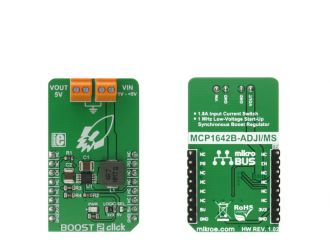
We strongly encourage users to use Package manager for sharing their code on Libstock website, because it boosts your efficiency and leaves the end user with no room for error. [more info]

Rating:
Author: MIKROE
Last Updated: 2018-03-13
Package Version: 1.0.0.0
mikroSDK Library: 1.0.0.0
Category: Boost
Downloaded: 6009 times
Not followed.
License: MIT license
Boost 2 click is a DC-DC step-up (boost) regulator that has a fixed 5V output, which can be obtained from any low voltage input - such as NiCd, NiMH or one cell Li-Po/Li-Ion batteries.
Do you want to subscribe in order to receive notifications regarding "Boost 2 click" changes.
Do you want to unsubscribe in order to stop receiving notifications regarding "Boost 2 click" changes.
Do you want to report abuse regarding "Boost 2 click".


Library description
This library contains functions that control the Enable pin and can retrieve the state of the PG pin.
Key functions:
void boost2_setENpin(uint8_t newState)- Sets the EN pin
uint8_t boost2_getPGpin()- Gets the status of the PG pin
Example description
The application is composed of three sections :
void applicationTask()
{
mikrobus_logWrite("Enabling click operation...", _LOG_LINE);
boost2_setENpin(1);
Delay_ms(3000);
mikrobus_logWrite("Checking output voltage...", _LOG_LINE);
Delay_ms(500);
if(boost2_getPGpin())
{
mikrobus_logWrite("Output voltage good.", _LOG_LINE);
}
else
{
mikrobus_logWrite("Output voltage incorrect.", _LOG_LINE);
}
Delay_ms(3000);
mikrobus_logWrite("Disabling click operation...", _LOG_LINE);
boost2_setENpin(0);
Delay_ms(5000);
}
MikroElektronika libraries used in this example:
Additional notes and information
Depending on the development board you are using, you may need USB UART click, USB UART 2 clickor RS232 click to connect to your PC, for development systems with no UART to USB interface available on the board. The terminal available in all MikroElektronika compilers, or any other terminal application of your choice, can be used to read the message.